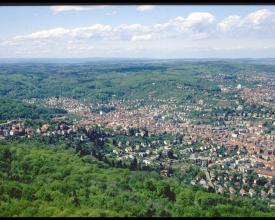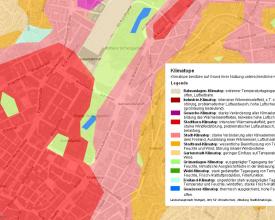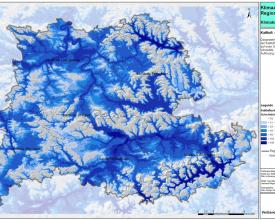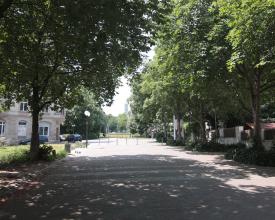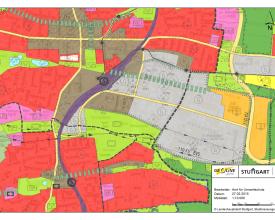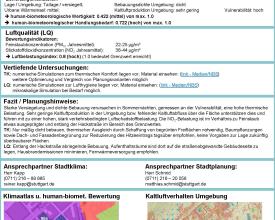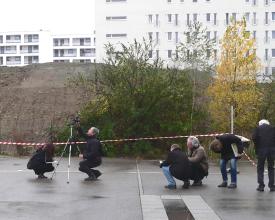
Couloirs d'aération verts dans la ville de Stuttgart
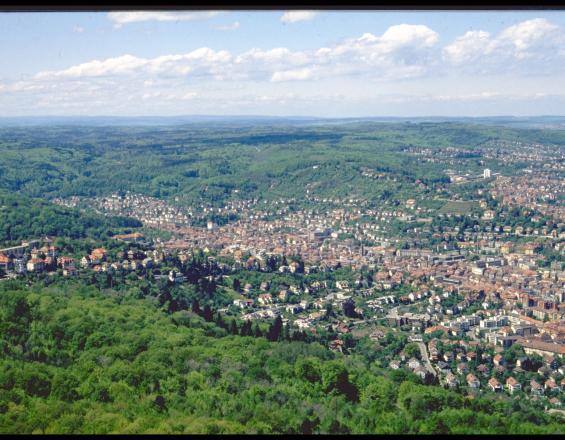
À Stuttgart, d'importantes ceintures et lignes de démarcation vertes s'étendent entre les zones d'habitation construites, atténuant ainsi le stress thermique du climat. La verdure couvre aujourd'hui plus de 60 % de la zone. En outre, plus de 39 % de la surface de Stuttgart a été placée sous la protection d'ordonnances de conservation de la nature. L'intégration de ces éléments importants dans un plan d'occupation des sols, ainsi que la politique de ceinture verte, sont les domaines d'influence municipale les plus prometteurs en ce qui concerne leur impact sur la climatologie urbaine et la protection du climat.
Contexte
Défis à relever
L'emplacement de la ville, son climat et l'effet d'îlot de chaleur contribuent à la mauvaise qualité de l'air et au stress thermique fréquemment ressenti par les personnes. En outre, le stress thermique dû aux vagues de chaleur risque d'augmenter avec le changement climatique, ce qui aura des répercussions sur les personnes vulnérables telles que les personnes âgées. L'apport d'air frais et la réduction du stress thermique doivent prévaloir sur les efforts visant à fournir des logements supplémentaires et à acquérir des terrains à bâtir.
Emplacement
Traiter
Résumé du processus
Un atlas climatique pour Stuttgart (bloc 1) sert de base à la planification des mesures de création et de protection des espaces verts et des corridors (bloc 2), qui sont mises en œuvre par le biais d'un plan d'occupation des sols (bloc 3). À cela s'ajoute le "passeport Klipps-planification climatique de Stuttgart" (bloc 4), qui est un outil d'évaluation permettant d'identifier les zones et de planifier des actions contre le stress thermique subi par la population. Enfin, la participation des parties prenantes et les partenariats (bloc 5) sont à la base de la réussite du programme.
Blocs de construction
Atlas du climat
L'Atlas climatique de la région de Stuttgart a été publié en 2008 et comprend des évaluations climatiques standardisées pour 179 villes et municipalités de la région de Stuttgart. Il fournit des informations et des cartes pertinentes nécessaires à l'optimisation du climat urbain, telles que le régime des vents régionaux, les concentrations de pollution atmosphérique, la température, etc.
Un élément clé de l'atlas en termes de planification EbA pour la circulation de l'air et le refroidissement est une classification des zones basée sur le rôle que les différents lieux jouent dans le renouvellement de l'air et la circulation de l'air frais dans la région de Stuttgart. Cette classification est basée sur la topographie, la densité et le caractère du développement, ainsi que sur la présence d'espaces verts. L'Atlas distingue ainsi huit catégories de zones, pour chacune desquelles des mesures d'aménagement et des recommandations sont proposées.
Les recommandations de planification ont été incluses dans le "Livret climatique pour le développement urbain en ligne - Städtebauliche Klimafibel Online".
Facteurs favorables
L'atlas s'appuie sur les travaux antérieurs menés dans ce domaine par la ville de Stuttgart depuis les années 1980 et le service interne de climatologie urbaine (qui existe dans la ville de Stuttgart depuis 1938). En effet, un atlas climatique a été publié en 1992, sur la base duquel l'atlas actuel a été développé.
Leçon apprise
Les cartes sont des outils importants pour la planification et la communication d'informations aux parties prenantes concernées. Elles sont nécessaires pour atteindre les objectifs en matière de climat et de qualité de l'air.
L'étude fournit des informations importantes qui peuvent être utilisées pour la protection du climat et les recommandations portent notamment sur la transformation des espaces verts et de la végétation dans la ville construite et sur la préservation et la restauration de la végétation naturelle, notamment en garantissant des corridors verts.
Espaces verts et corridors
Les structures topographiques telles que les vallées des cours d'eau et des prairies constituent des ceintures vertes naturelles qui représentent en même temps des voies privilégiées pour la ventilation, tandis que les espaces verts sont bénéfiques pour le climat urbain et sa protection :
- La végétation exerce un effet stabilisateur important sur l'équilibre du CO2, rafraîchit la zone et améliore la qualité de l'air.
- Les espaces verts servent à préserver les lieux, en éliminant d'autres utilisations qui pourraient avoir un impact négatif sur la protection du climat en raison d'émissions potentielles importantes pour le climat, telles que les routes ou les bâtiments.
- Lorsque la végétation est plus basse et moins dense, les espaces verts favorisent la ventilation dans les zones bâties en générant de l'air froid par le biais de systèmes de vents locaux induits thermiquement, tels que les vents du sol et les vents descendants, et agissent ainsi comme des couloirs d'air frais. Cela réduit l'exposition aux polluants et dissipe l'accumulation de chaleur et le stress thermique, en particulier pendant les périodes de chaleur extrême.
- Là où la végétation est plus haute et plus dense, la vitesse élevée du vent pendant les tempêtes est atténuée. En outre, les forêts jouent un rôle majeur en termes de protection contre l'érosion des sols due aux fortes pluies et aux tempêtes.
Ces espaces verts sont protégés et/ou créés à Stuttgart par le biais du plan d'occupation des sols.
Facteurs favorables
Les cartes climatiques et d'hygiène de l'air constituent une base technique indispensable pour la planification des corridors verts.
De nombreux aspects juridiques soutiennent la préservation et la création d'espaces et de corridors verts, notamment les réglementations relatives à la protection de la nature et la loi fédérale allemande sur la construction, qui a été révisée en 2004 et exige désormais une protection environnementale de précaution dans les pratiques de zonage et de planification urbaine.
Leçon apprise
Il n'est pas nécessaire d'être très persuasif pour préserver les corridors verts naturels de l'empiètement des bâtiments, étant donné que les aspects de la conservation du paysage et de la nature soutiennent également les arguments de la climatologie urbaine. Cette argumentation commune s'est surtout manifestée dans le débat sur la conservation du quartier des vergers de Greutterwald (Stuttgart-Weilimdorf).
Les corridors et les réseaux verts sont plus importants pour les objectifs climatiques que les petits espaces verts isolés, qui n'ont qu'un impact à distance minime sur leur environnement en raison de ce que l'on appelle "l'effet oasis". Toutefois, cette considération n'enlève rien à l'importance de l'absorption de la température par toutes les zones de végétation.
Plan d'occupation des sols
Un plan préparatoire d'occupation des sols (PLUP) a été entrepris, qui organise le terrain en fonction des bâtiments et d'autres types d'utilisation et inclut des zones vertes et des corridors. Ce plan n'est pas juridiquement contraignant, mais sert de base à la planification et à l'information.
Le plan d'occupation des sols élaboré en 2010 contient des éléments essentiels pour un développement urbain durable, envisageant le développement urbain sous le slogan "urban─compact─green". Sa ligne directrice est de privilégier le développement des friches industrielles plutôt que des terrains vierges, dans un rapport de 4:1. Elle vise à protéger les zones vertes et à développer un réseau vert à travers les zones de friche.
Facteurs favorables
L'utilisation constructive des réglementations existantes (par exemple, la loi fédérale allemande sur la construction) fournit un mandat pour la mise en œuvre des recommandations de planification relatives au climat local.
En outre, la ville dispose d'une stratégie d'atténuation du changement climatique depuis 1997 et une stratégie d'adaptation au changement climatique a été élaborée en 2012.
Enfin, la présence d'une section de climatologie urbaine au sein de l'Office pour la protection de l'environnement a permis de créer les données nécessaires.
Leçon apprise
Disposer d'une capacité interne de recherche climatique au sein d'une municipalité est rare, mais c'est un avantage considérable pour fournir des connaissances et des solutions concrètes, plutôt que d'appliquer des principes généraux lors de la création d'un plan d'occupation des sols qui peut répondre aux objectifs de protection du climat et de la qualité de l'air. Le fait de disposer de données détaillées et concrètes pour la ville a permis l'ingénierie, la planification et l'aménagement paysager d'un système complet de circulation de l'air en milieu urbain.
KLIPPS - Méthode d'évaluation de la qualité humano-biométéorologique des zones urbaines confrontées à la chaleur estivale
Outre l'amélioration des conditions générales liées à l'augmentation des températures, la ville de Stuttgart a conçu un projet innovant intitulé "KlippS - Climate Planning Passport Stuttgart", basé sur des résultats quantitatifs en biométéorologie urbaine, afin d'améliorer le confort thermique humain. Le projet KlippS calcule la sensation thermique humaine dans la catégorie "chaud" pendant la journée en été. KlippS est divisé en deux phases : la première concerne l'évaluation rapide du stress thermique humain pour les zones concernées par la "gestion durable des terrains à bâtir de Stuttgart", la seconde se concentre sur les simulations numériques dans les zones urbaines à haut risque liées à la chaleur.
KlippS fournit les questions remarquables suivantes sur le potentiel de planification pour atténuer le stress thermique humain local :
a) programme innovant impliquant le concept de biométéorologie humaine, qui représente un nouveau domaine interdisciplinaire
b) différentes échelles spatiales, y compris les échelles régionale et locale, sur la base de la méthode systématique en deux phases
c) approche quantitative du stress thermique humain à l'aide de variables météorologiques dominantes telles que la température de l'air T, la température radiante moyenne MRT et la température thermophysiologiquement équivalente PET
Facteurs favorables
En tant que projet en cours, les résultats du projet KlippS ont été discutés lors de réunions internes avec le département de l'administration et le conseil local de la ville de Stuttgart. Sur la base de ces réunions, des mesures pratiques sont prévues pour être mises en œuvre dès que possible.
Leçon apprise
Les personnes souffrent de stress thermique en raison de la combinaison d'un temps extrêmement chaud à l'échelle régionale et de la complexité des centres urbains à l'échelle locale. En principe, il existe trois options pour atténuer les effets locaux des fortes chaleurs sur les citoyens :
a) les systèmes d'alerte à la chaleur des services météorologiques nationaux
b) l'adaptation du comportement individuel face aux fortes chaleurs
c) l'application de mesures de planification liées à la chaleur
Alors que les options a) et b) fonctionnent à court terme, l'option c) représente un moyen de prévention à long terme. Dans cette perspective, KlippS a été conçu pour développer, appliquer et valider des mesures qui contribuent à une réduction locale des fortes chaleurs.
Le projet KlippS a été abordé lors de nombreuses réunions et ateliers, notamment lors de l'atelier public "Changement climatique et adaptation dans le sud-ouest de l'Allemagne", qui a rassemblé 250 participants le 17 octobre 2016 à Stuttgart. En plus des ateliers, KlippS a été présenté lors de nombreuses conférences scientifiques nationales et internationales.
Participation des parties prenantes et partenariat
Les partenariats et la collaboration entre les différents organismes publics sont nécessaires au développement et à la mise en œuvre des activités.
En outre, la participation du public est requise pour l'élaboration d'un plan d'occupation des sols et fait également partie de la mise en œuvre de stratégies vertes visant à améliorer la qualité de l'air et à atténuer le stress thermique. Par exemple, depuis 1992, un programme permet aux habitants de Stuttgart d'adopter un arbre, dont ils sont également responsables.
Facteurs favorables
Le fait d'avoir un maire qui soutient les activités écologiques, la législation et les stratégies pertinentes, ainsi que les installations de recherche internes, peut contribuer à assurer une collaboration transversale.
Leçon apprise
Les partenariats entre la ville de Stuttgart et la Verband Region Stuttgart (l'association des villes et municipalités régionales) ont permis la création de l'atlas climatique 2008.
En outre, grâce à une étroite collaboration entre l'Office pour la protection de l'environnement (analyse des informations, formulation de recommandations) et l'équipe chargée de la planification et du renouvellement de la ville, les solutions recommandées en matière d'infrastructures vertes sont mises en œuvre dans le cadre de la planification spatiale et du contrôle du développement.
Impacts
Le climat urbain, y compris la qualité de l'air, est amélioré et le stress thermique est atténué grâce aux corridors verts et aux espaces verts. Les communautés sont ainsi mieux protégées contre les effets du changement climatique, tels que l'augmentation des températures ou les changements de précipitations. En outre, les espaces verts offrent d'importants avantages en termes de loisirs et de bien-être. Enfin, la biodiversité est préservée grâce à l'entretien des espaces verts et des corridors verts, ce qui contribue également à la séquestration du carbone.
Bénéficiaires
Les habitants de la ville de Stuttgart en bénéficient doublement : la qualité de l'air est améliorée et le stress thermique est réduit. La biodiversité bénéficie également de cette solution.
Objectifs de développement durable
Histoire
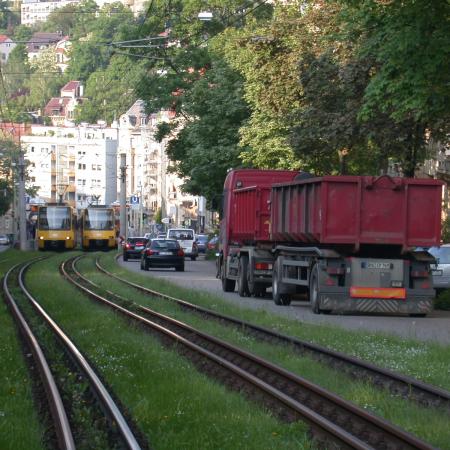
Depuis 1938, la municipalité de Stuttgart dispose d'un département de climatologie urbaine au sein de l'Office pour la protection de l'environnement, afin de prendre en compte le climat dans la planification urbaine et de s'assurer que la situation climatique locale ne sera pas détériorée par la planification.
Le stress thermique et la sensibilité aux effets de la chaleur sont fréquents en combinaison avec le climat doux d'une région viticole. Le deuxième handicap de Stuttgart en matière de climat et d'hygiène de l'air provient de son manque de vent, à savoir l'augmentation épisodique de la pollution de l'air.
En effet, l'objectif premier de la région de Stuttgart en matière de protection du climat est de faciliter l'échange d'air dans la ville et d'augmenter ainsi le potentiel de flux d'air frais des collines vers les zones urbaines situées au fond de la vallée. Un plan d'occupation des sols, basé sur les recommandations des études climatiques, a prévu la protection et la création de corridors et d'espaces verts. Des recommandations précises sont incluses pour ces espaces verts afin de maximiser le flux d'air.
Il a été démontré que les corridors et les espaces verts bien conçus assurent la ventilation dans toute la zone, ce qui présente de nombreux avantages sur le plan climatique, tels que le refroidissement de la température de l'air, qui atténue le stress climatique pendant les vagues de chaleur, et la réduction de la pollution atmosphérique, tout en apportant de nombreux autres avantages tels que la conservation de la biodiversité, la séquestration du carbone et les avantages récréatifs.
Stuttgart est l'une des rares villes allemandes à avoir plus de 39 % de sa superficie placée sous la protection d'arrêtés de conservation de la nature. D'autres espaces verts innovants ont également été créés à l'intérieur de la ville, comme les toits verts, la végétalisation des façades et les rails verts (herbe cultivée entre les lignes de tramway).
Une courte vision de l'avenir pourrait devenir réalité :
Imaginez que vous vous promenez dans les rues de Stuttgart. C'est une journée d'été très chaude, mais vous n'avez pas à transpirer. Les couronnes d'arbres le long de la rue vous donnent de l'ombre. Vous utilisez un petit parc comme voie de passage, ici c'est à nouveau plus agréable. L'air que vous respirez est pur. L'après-midi dans votre bureau est également agréable, car le bâtiment est doté d'un toit vert et d'une façade verte. Quelques grands arbres à feuilles épargnent le rayonnement direct du soleil dans votre bureau, de sorte que vous n'avez pas besoin d'air conditionné. Plus tard, vous terminez votre travail et profitez de la soirée. Avant de vous coucher, vous ouvrez la fenêtre de votre chambre à coucher. Une brise fraîche vous permet de vous endormir.
Un sommeil profond est très bénéfique !
